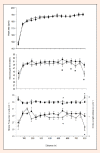The effect of a silicone swim cap on swimming performance in tropical conditions in pre-adolescents
- PMID: 24149132
- PMCID: PMC3737839
The effect of a silicone swim cap on swimming performance in tropical conditions in pre-adolescents
Abstract
We tested whether the silicone swim caps (SC) worn by young swimmers in a tropical climate negatively influence aerobic performance. Nine trained pre- adolescents [11.8 (± 0.8) years] swam randomized 800-m trials (water: 32.9°C, outdoors: shade, 29.2 ± 0.2 °C, 74 ± 0.3 % rh) with a SC or a nude head (NH). Performance times and heart rate (HR) were monitored continuously. Rectal temperature (Trec) was measured before and after trials. The rating of perceived exertion (RPE) was assessed. Stroke frequency (SF), stroke length (SL) and stroke index (SI) were measured every 50-m. The SC trial was significantly longer than NH (799 ± 16 and 781 ± 16 seconds, respectively). Mean delta Trec was significantly greater in SC (0.2 ± 0.1°C vs. -0.1 ± 0.1°C in SC vs. NH), mean SI was significantly different in SC versus NH (1.83 ± 0.07 vs 1.73 ± 0.06); but RPE and mean HR, SF and SL showed no change. We conclude that a silicone swim cap worn in tropical environment significantly decreased 800-m crawl performance without affecting HR or RPE. Silicone swim caps worn by young swimmers in a tropical environment may also have negative effects on training capacity. Key pointsSwimming in tropical climate represents a physiological stressSwimming with swim cap in warm water could induce thermal stressThermoregulation processes have to be used in order to make training in tropical climate safer.
Keywords: Swimming; aerobic exercise; hot/wet environment; performance; pre-adolescents.
Figures
Similar articles
-
Warm-up for Sprint Swimming: Race-Pace or Aerobic Stimulation? A Randomized Study.J Strength Cond Res. 2017 Sep;31(9):2423-2431. doi: 10.1519/JSC.0000000000001701. J Strength Cond Res. 2017. PMID: 27806010 Clinical Trial.
-
The effect of time of day on cold water ingestion by high-level swimmers in a tropical climate.Int J Sports Physiol Perform. 2013 Jul;8(4):442-51. doi: 10.1123/ijspp.8.4.442. Epub 2013 Jan 4. Int J Sports Physiol Perform. 2013. PMID: 23295257
-
Hyperthermia during Olympic triathlon: influence of body heat storage during the swimming stage.Med Sci Sports Exerc. 1998 Jan;30(1):99-104. doi: 10.1097/00005768-199801000-00014. Med Sci Sports Exerc. 1998. PMID: 9475650
-
Cardiovascular and Perceptual Responses to an Ultraendurance Channel Swim: A Case Study.Wilderness Environ Med. 2015 Sep;26(3):359-65. doi: 10.1016/j.wem.2015.02.003. Epub 2015 Mar 24. Wilderness Environ Med. 2015. PMID: 25819111
-
The effect of cold water endurance swimming on core temperature in aspiring English Channel swimmers.Extrem Physiol Med. 2016 Feb 1;5:3. doi: 10.1186/s13728-016-0044-2. eCollection 2016. Extrem Physiol Med. 2016. PMID: 26835005 Free PMC article.
Cited by
-
Face Cooling During Swimming Training in Tropical Condition.Front Psychol. 2021 Apr 23;12:622184. doi: 10.3389/fpsyg.2021.622184. eCollection 2021. Front Psychol. 2021. PMID: 33967888 Free PMC article.
-
A pilot study on how do elite surfski padllers manage their effort and hydration pattern in the heat.Biol Sport. 2014 Dec;31(4):283-8. doi: 10.5604/20831862.1120936. Epub 2014 Sep 12. Biol Sport. 2014. PMID: 25435671 Free PMC article.
-
Hydration and thermoregulation during a half-ironman performed in tropical climate.J Sports Sci Med. 2015 May 8;14(2):263-8. eCollection 2015 Jun. J Sports Sci Med. 2015. PMID: 25983573 Free PMC article.
-
Ingestion of a cold temperature/menthol beverage increases outdoor exercise performance in a hot, humid environment.PLoS One. 2015 Apr 9;10(4):e0123815. doi: 10.1371/journal.pone.0123815. eCollection 2015. PLoS One. 2015. PMID: 25856401 Free PMC article.
-
Self-hydration and thermoregulatory processes of average-level paddlers during international surfski events in a tropical climate.Biol Sport. 2015 Dec;32(4):329-332. doi: 10.5604/20831862.1188610. Epub 2015 Dec 26. Biol Sport. 2015. PMID: 28479662 Free PMC article.
References
-
- Al Haddad H.A., Laursen P.B., Ahmaidi S., Bucheit M.(2010). Influence of cold water face immersion on post-exercise parasympathetic reactivation. European Journal of Applied Physiology 108, 599-606 - PubMed
-
- American Academy of Pediatrics. Committee on Sports Medicine and Fitness (2000) Climatic Heat Stress and the Exercising Child and Adolescent. Pediatrics 106, 158-159 - PubMed
-
- Anderson G.S., Mekjavic I.B.(1996) Thermoregulatory responses of circum-pubertal children. European Journal of Applied Physiology and Occupational Physiology. 74, 404-410 - PubMed
-
- Aquatic Exercise Association (2008) 2008 Standards and Guidelines for Aquatic Fitness Programming: The Global Resource in Aquatic Fitness. 2-4
-
- Armada-da-Silva P.A., Woods J., Jones D.A.(2004) The effect of passive heating and face cooling on perceived exertion during exercise in the heat. European Journal of Applied Physiology, 91, 563-571 - PubMed
LinkOut - more resources
Full Text Sources
Miscellaneous

